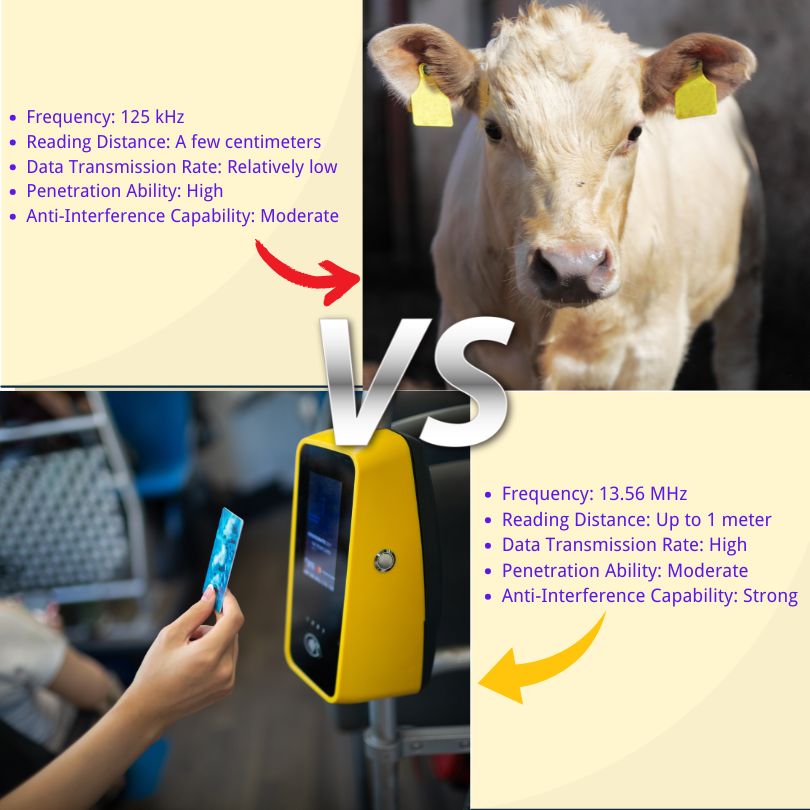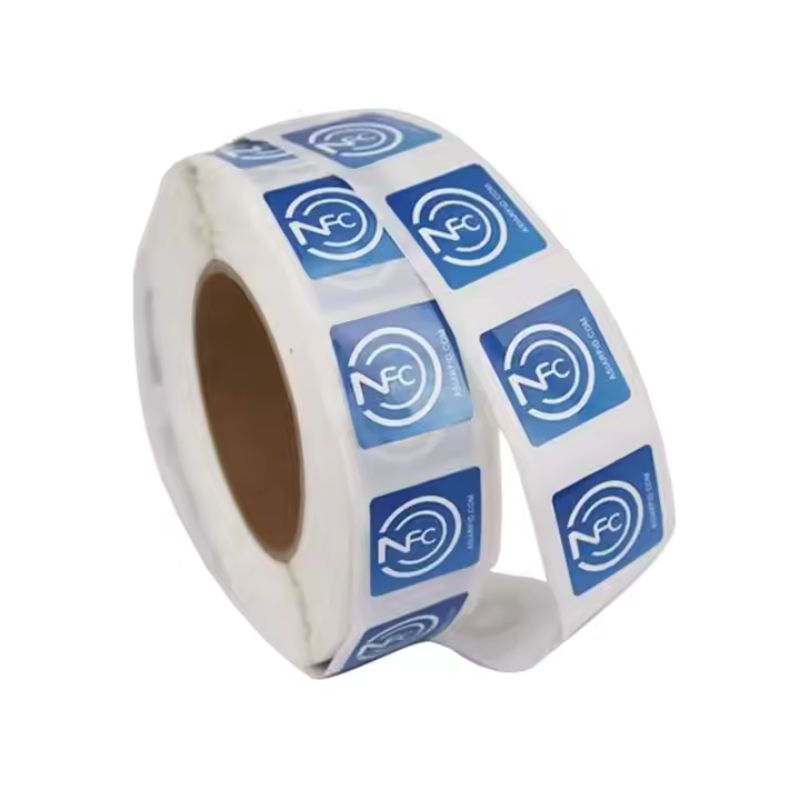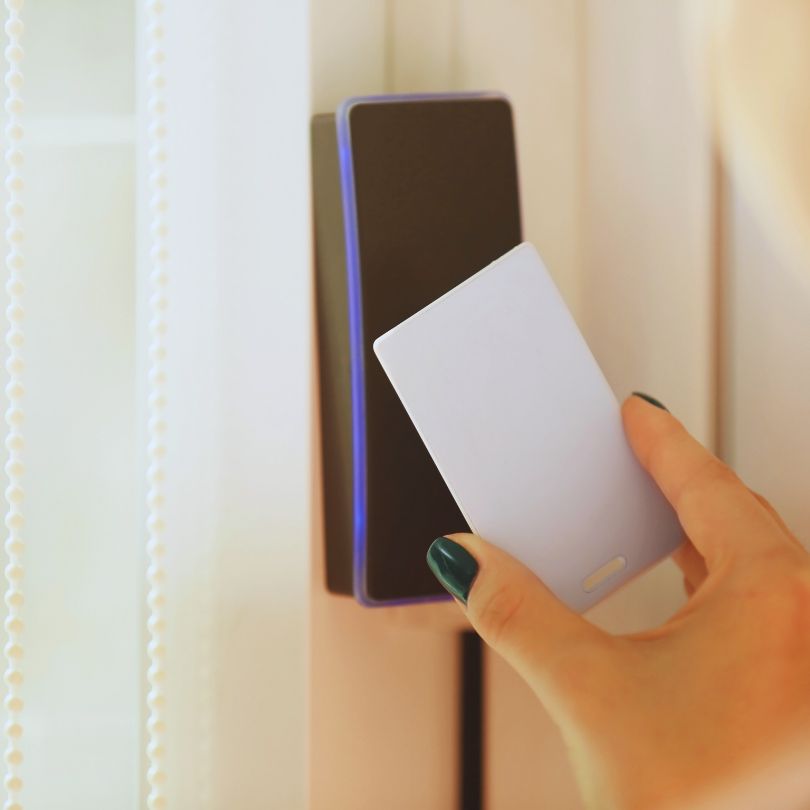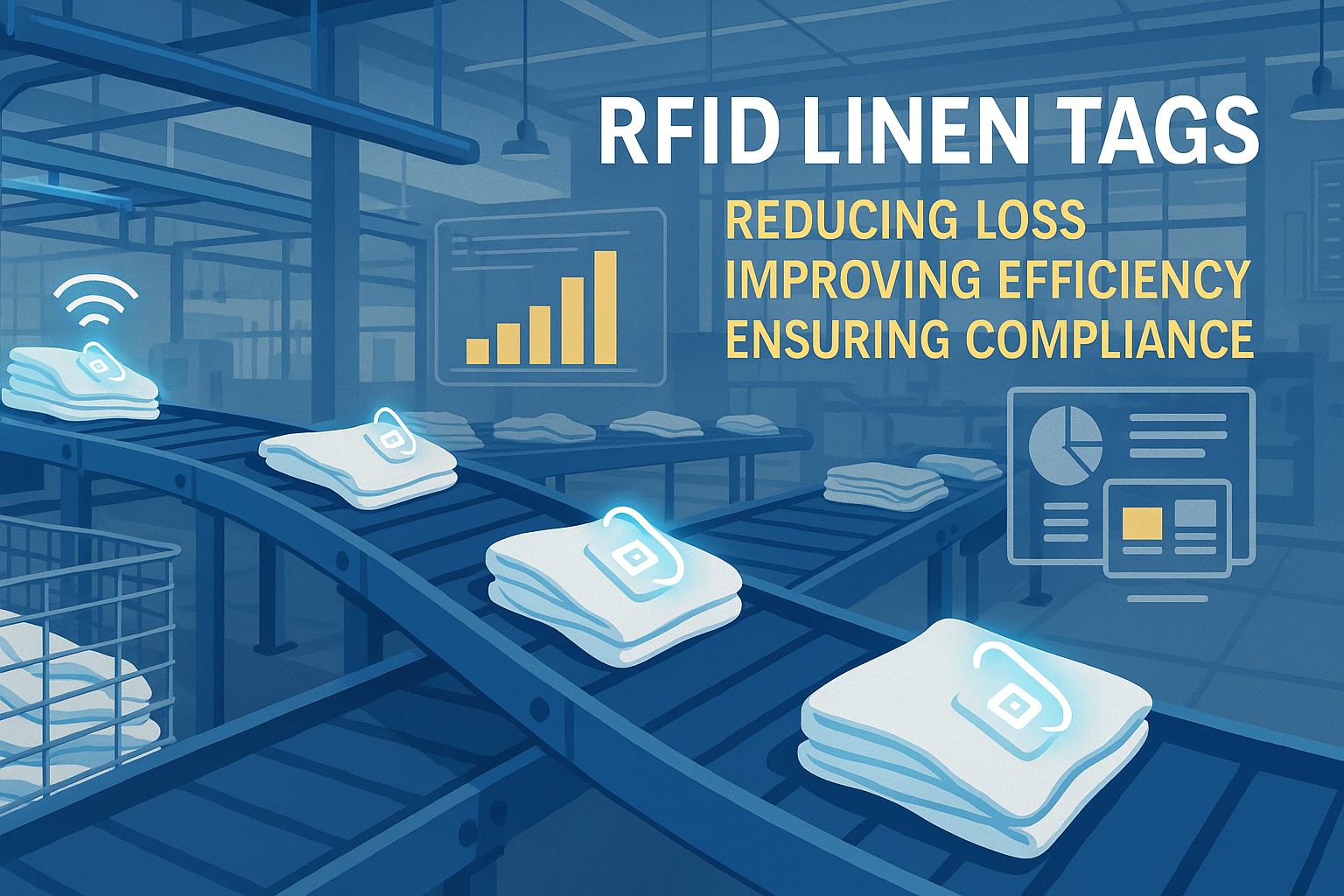
Comprender las diferencias entre las etiquetas RFID de 13,56 MHz y 125 kHz
Tabla de contenido
Comprender las diferencias entre las etiquetas RFID de 13,56 MHz y 125 kHz

¿Qué significa realmente la frecuencia RFID (LF frente a HF)?
Los sistemas RFID utilizan ondas de radio para comunicarse entre sí. etiquetas y lectores. La frecuencia que utilizan afecta a la distancia a la que pueden leer, la velocidad a la que envían datos, su comportamiento en presencia de metal o agua y el tipo de datos que pueden almacenar.
Esta es la idea central:
Etiquetas RFID de baja frecuencia (LF) = 125 kHz
- Corto alcance
- Velocidad de datos más lenta
- Excelente rendimiento cerca de metales o líquidos
- Sencillo, resistente y asequible.
Alta frecuencia (HF) = Etiquetas RFID de 13,56 MHz - Mayor alcance
- Mayor velocidad de transmisión de datos
- Seguridad más avanzada
- Compatible con NFC y teléfonos inteligentes
13,56 MHz frente a 125 kHz
| Característica | Etiquetas RFID de 13,56 MHz | Etiquetas RFID de 125 kHz |
|---|---|---|
| Frecuencia | 13,56 MHz (alta frecuencia) | 125 kHz (LF) |
| Rango de lectura | Hasta 1 metro | 2-10 cm |
| Velocidad de transferencia de datos | Alto | Bajo |
| Rendimiento cerca del metal | Moderado | Fuerte |
| Seguridad | Admite cifrado y autenticación mutua. | Básico, normalmente sin cifrado. |
| Compatibilidad con NFC/teléfonos inteligentes | Sí | No |
| Costo | Más alto | Más bajo |

Seguridad: ¿Es más segura una sola frecuencia?
Etiquetas RFID de 125 kHz Se utilizan a menudo en sistemas antiguos y suelen emplear identificadores únicos fijos sin cifrado. Esto hace que sean fáciles de clonar con dispositivos comerciales. Son adecuados para sistemas de bajo riesgo, pero no cumplen con los estándares de seguridad modernos.
Las etiquetas RFID de 13,56 MHz, especialmente las tarjetas MIFARE o DESFire, admiten:
- Encriptación
- Autenticación mutua
- Almacenamiento seguro de memoria
- Múltiples aplicaciones en una sola tarjeta
En resumen: - Utilice etiquetas RFID de 125 kHz para necesidades de baja seguridad (como llaves de taquillas, relojes registradores).
- Elija 13,56 MHz para el control de acceso, los pagos o cualquier sistema que almacene datos personales.
Compatibilidad con NFC y teléfonos inteligentes
Si su proyecto incluye teléfonos, las etiquetas RFID de 125 kHz no funcionarán.
Solo Etiquetas RFID de 13,56 MHz Compatible con NFC (Near Field Communication), la tecnología utilizada en pagos móviles, registros y funciones de emparejamiento con un solo toque.
La mayoría de los teléfonos inteligentes pueden leer y escribir etiquetas NFC utilizando 13,56 MHz, lo que hace que esta frecuencia sea ideal para:
- Entradas digitales
- Registros de eventos
- Carteles inteligentes
- Tarjetas de fidelidad
- Identificación móvil sin contacto
Si la compatibilidad con teléfonos inteligentes es importante, 13,56 MHz es tu única opción.
Casos de uso reales por sector
| Industria / Aplicación | Etiquetas RFID de 125 kHz | Etiquetas RFID de 13,56 MHz |
|---|---|---|
| Control de acceso | Sistemas de entrada básicos, puertas antiguas | Credenciales seguras, tarjetas de identificación modernas |
| Transporte público / Venta de billetes | No compatible | Tarjetas de transporte basadas en MIFARE/NFC |
| Rastreo de animales | Ampliamente utilizado debido a su penetración en los tejidos. | Raro |
| Automatización industrial | Fiable cerca de metales/líquidos, uso intensivo | Menos común en entornos hostiles |
| Cuidado de la salud | No es ideal para el seguimiento de pacientes o medicamentos. | Mejor para la identificación segura y el etiquetado de activos. |
| Bibliotecas / Archivos | Raro | Popular para el seguimiento y préstamo de libros. |
| Marketing / Eventos | No aplicable | Carteles inteligentes, pases para eventos NFC |
| Antirrobo para vehículos | Etiquetas RFID integradas de 125 kHz en llaves/encendidos | No utilizado |

Cómo elegir entre 13,56 MHz y 125 kHz para su proyecto
Utiliza esta lista de verificación para acotar tu decisión:
1. Nivel de seguridad
- ¿Necesitas cifrado o acceso seguro? → Opta por 13,56 MHz.
- ¿Seguimiento de bajo riesgo o identificación básica? → 125 kHz puede ser suficiente.
2. Medio ambiente
- ¿Hay mucha interferencia, metales o líquidos cerca? → 125 kHz funciona mejor.
- ¿Oficina limpia o espacio interior? → Cualquiera de los dos vale; elige en función de las características.
3. Integración con teléfonos inteligentes
- ¿Quieres que los usuarios escaneen con sus teléfonos? → Solo 13,56 MHz es compatible con esta función.
4. Presupuesto
- Las etiquetas de 125 kHz son más baratas inicialmente.
- Pero 13,56 MHz ofrece más valor a largo plazo si necesita funciones o seguridad.
¿Sigue utilizando etiquetas RFID de 125 kHz? ¿Actualizar o quedarse?
Las etiquetas RFID de 125 kHz siguen utilizándose ampliamente en:
- Sistemas de control de acceso heredados
- Operaciones en la planta de producción
- Marcado del ganado
- Sistemas antirrobo automáticos
Pero si estás gestionando: - Credenciales del personal
- Sistemas de pago
- Tarjetas de identificación multiuso
- Integración NFC
... entonces tal vez sea hora de cambiar.
Rutas de actualización:
- Instalar lectores de doble frecuencia.
- Emitir tarjetas combinadas (compatibles con 13,56 MHz y 125 kHz).
- Implementación gradual: compatibilidad con ambos sistemas durante la migración.
Preguntas frecuentes sobre RFID de 13,56 MHz frente a 125 kHz
¿13,56 MHz es lo mismo que NFC?
Sí, NFC es un tipo de RFID de 13,56 MHz. La mayoría de los teléfonos inteligentes lo admiten.
¿Puede un lector leer ambas frecuencias?
Normalmente no. Necesitarás un lector de doble tecnología para manejar ambos.
¿Qué etiqueta tiene mayor alcance?
13,56 MHz suele tener un alcance de lectura mayor (hasta 1 metro). 125 kHz está limitado a unos pocos centímetros.
¿Cuál debería utilizar para el control de acceso?
Para sistemas de acceso modernos y seguros, se recomienda encarecidamente utilizar 13,56 MHz.
¿Por qué las etiquetas RFID de 13,56 MHz y 125 kHz tienen diferentes distancias de lectura?
La diferencia en las distancias de lectura se debe principalmente a la frecuencia de funcionamiento. Las frecuencias más altas, como 13,56 MHz, tienen un mayor alcance, mientras que las frecuencias más bajas, como 125 kHz, están optimizadas para distancias más cortas.
¿Qué etiqueta RFID es más adecuada para entornos metálicos o líquidos?
Las etiquetas RFID de 125 kHz son más efectivas en entornos con metales o líquidos debido a su capacidad de penetración superior.
¿El coste de las etiquetas RFID influye en la elección?
Sí, las etiquetas RFID de 125 kHz suelen ser más rentables, lo que las convierte en una opción adecuada para aplicaciones con presupuestos ajustados. Sin embargo, la elección también debe tener en cuenta los requisitos de rendimiento y los entornos de aplicación.
Normas clave y tipos de chips
13,56 MHz (alta frecuencia)
- ISO/IEC 14443: Utilizada en tarjetas sin contacto (MIFARE, DESFire).
- ISO/IEC 15693: Mayor alcance, utilizado en bibliotecas y logística.
- ISO 18000-3: Seguimiento a nivel de artículo
125 kHz (LF)
- Formatos propietarios, a menudo con identificación fija (por ejemplo, EM4100, HID Prox)
- Se utiliza principalmente en sistemas antiguos y aplicaciones básicas.
Conclusiones finales
Si todavía te estás preguntando qué camino tomar, aquí tienes un resumen:
Utilice etiquetas RFID de 125 kHz para:
- Condiciones adversas (metal/líquido)
- Aplicaciones de baja seguridad
- Implementaciones conscientes del presupuesto
- Sistemas heredados
Utilice etiquetas RFID de 13,56 MHz para:
- Compatibilidad con dispositivos móviles/NFC
- Acceso y pago seguros
- Tarjetas multiuso
- Sistemas preparados para el futuro
Ambos tienen su lugar, pero debes elegir en función del uso que le vayas a dar, no solo por el coste o por costumbre.
Comentarios
Productos destacados

¿Qué es la gestión de residuos mediante RFID?
Imagina una ciudad en la que todos los contenedores de basura hablan, no literalmente, sino a través de un pequeño chip que indica al sistema cuándo están llenos, cuándo se vacían y adónde van. Eso es lo que hace hoy en día la gestión de residuos mediante RFID.

¿Qué son las juntas de perno y sus aplicaciones? | Guía completa
En el comercio mundial y la logística, los precintos de seguridad desempeñan un papel crucial para garantizar la seguridad y el cumplimiento de las normas de la carga. Estos pequeños pero potentes dispositivos están diseñados para bloquear contenedores de transporte, remolques y puertas de carga con un mecanismo a prueba de manipulaciones.

¿Qué es un protector de tarjetas RFID? Ventajas, casos de uso y guía de compra
La tecnología RFID (identificación por radiofrecuencia) está en todas partes: en sus tarjetas de crédito, tarjetas de identificación, pases de transporte, llaves de habitaciones de hotel y mucho más. Ofrece rapidez y comodidad, pero también abre la puerta a un nuevo tipo de robo digital llamado "skimming". Ahí es donde entra en juego un protector de tarjetas RFID.

Pulseras RFID para eventos: Guía de compra a granel para organizadores
Las pulseras RFID para eventos se están convirtiendo en la solución a la que recurren los organizadores que necesitan una entrada más rápida, prevención del fraude y pagos sin efectivo en conciertos, festivales y recintos deportivos. A diferencia de las entradas de papel o los códigos QR, estas pulseras inteligentes utilizan chips integrados para agilizar el acceso, asegurar las transacciones y mejorar la experiencia de los invitados.

Cómo la etiqueta RFID en el parabrisas mejora el control de acceso de vehículos y los sistemas de peaje
En el vertiginoso mundo actual, la identificación de vehículos debe ser rápida, segura y sin contacto. Una etiqueta RFID en el parabrisas ofrece exactamente eso: una forma fiable de gestionar el cobro de peajes, el estacionamiento y el acceso sin detener los vehículos.

Ventajas de las etiquetas RFID para ropa blanca en lavanderías comerciales
Gestionar la lavandería en hospitales, hoteles o grandes servicios de lavandería es un gran trabajo. Cada día se lavan, clasifican y devuelven miles de sábanas, toallas y uniformes. Pero problemas como la pérdida de sábanas, los errores de clasificación y el recuento manual pueden costar mucho dinero a las empresas. Por ejemplo, los hoteles de tamaño medio pueden perder más de $200.000 al año por sábanas perdidas.
Ahí es donde entran en juego las etiquetas de lino RFID.
Etiquetas
BLOGS RELACIONADOS

¿Qué es la gestión de residuos mediante RFID?
Imagina una ciudad en la que todos los contenedores de basura hablan, no literalmente, sino a través de un pequeño chip que indica al sistema cuándo están llenos, cuándo se vacían y adónde van. Eso es lo que hace hoy en día la gestión de residuos mediante RFID.

¿Qué son las juntas de perno y sus aplicaciones? | Guía completa
En el comercio mundial y la logística, los precintos de seguridad desempeñan un papel crucial para garantizar la seguridad y el cumplimiento de las normas de la carga. Estos pequeños pero potentes dispositivos están diseñados para bloquear contenedores de transporte, remolques y puertas de carga con un mecanismo a prueba de manipulaciones.

¿Qué es un protector de tarjetas RFID? Ventajas, casos de uso y guía de compra
La tecnología RFID (identificación por radiofrecuencia) está en todas partes: en sus tarjetas de crédito, tarjetas de identificación, pases de transporte, llaves de habitaciones de hotel y mucho más. Ofrece rapidez y comodidad, pero también abre la puerta a un nuevo tipo de robo digital llamado "skimming". Ahí es donde entra en juego un protector de tarjetas RFID.




